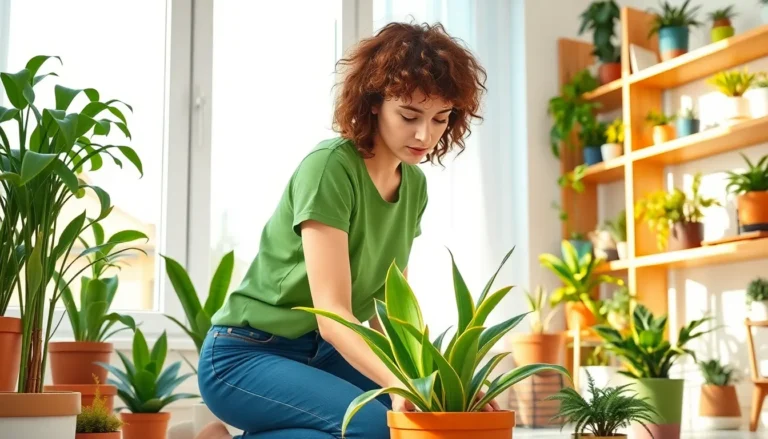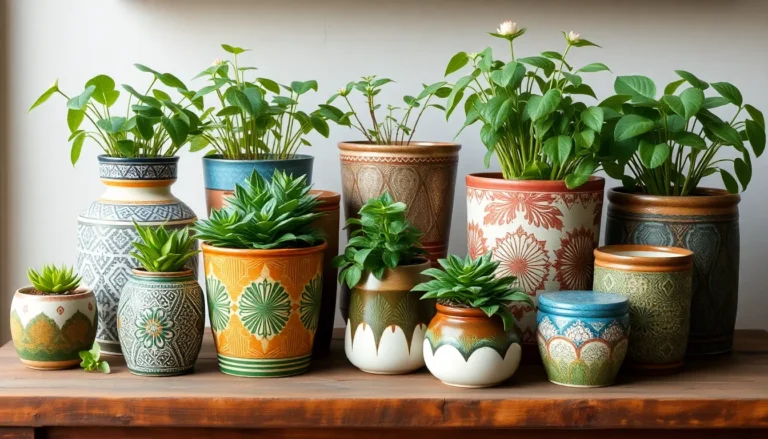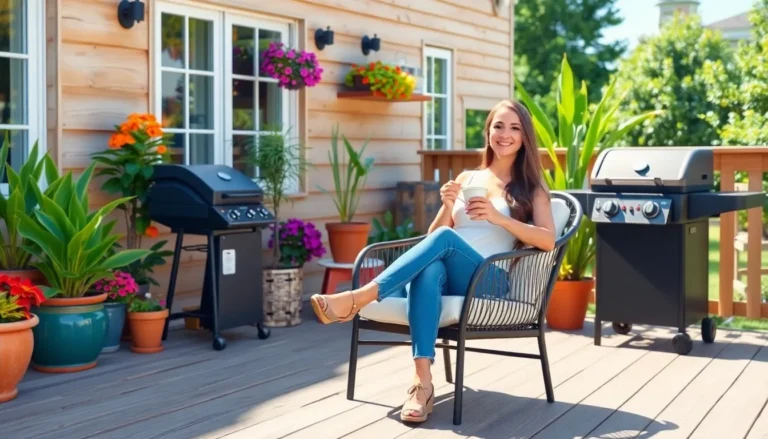Tropical house plants are the ultimate green companions that can transform any dull space into a vibrant oasis. They’re not just plants; they’re like little pieces of paradise that can thrive indoors while you sip your coffee and pretend you’re on a beach somewhere. Who wouldn’t want a little slice of the tropics right in their living room?
Table of Contents
ToggleOverview of Common Tropical House Plants
Tropical house plants bring both color and life to indoor environments. They thrive in conditions similar to their native habitats, often characterized by high humidity and warm temperatures. Common varieties include:
- Philodendron: Known for its heart-shaped leaves, it requires indirect sunlight and moderate watering. This plant adapts well to various indoor settings.
- Snake Plant: Resilient and low maintenance, it tolerates neglect and thrives in low light. It also helps purify the air by filtering toxins.
- Pothos: Often chosen for its trailing vines, it grows quickly and does well in low light. Regular pruning encourages bushier growth.
- Peace Lily: Featuring white flowers, it flourishes in shady spots and alerts owners when it needs water by drooping. This plant is also known for removing harmful pollutants.
- Fiddle Leaf Fig: Recognized for its large, dramatic leaves, it prefers bright, filtered light. It adds a striking focal point to any room.
- Rubber Plant: With glossy leaves, it’s another air purifier and grows well in diverse lighting conditions. This plant can reach significant heights with proper care.
These plants not only enhance aesthetic appeal but also improve air quality and humidity levels. Many people find joy in nurturing these vibrant companions. Choosing the right tropical house plants depends on individual preferences, available space, and light conditions. Each variety offers unique benefits, making them popular choices for indoor gardening.
Popular Varieties
Numerous tropical house plants offer unique beauty and easy care. Here are some popular varieties that thrive indoors.
Monstera Deliciosa
Monstera Deliciosa, known for its large, dramatic leaves, brings a bold touch to any space. This plant thrives in bright, indirect light, making it a great choice for many indoor areas. Watering should occur when the top inch of soil feels dry. Its iconic split leaves not only catch the eye but also filter air, enhancing indoor quality.
Pothos
Pothos is a versatile plant perfect for beginners and experienced gardeners alike. It adapts to various light conditions, including low light, which makes it suitable for dark corners. Regular watering keeps this plant vibrant, allowing soil to dry slightly between sessions. Pothos trails beautifully from pots, creating an elegant look while purifying the air.
Fiddle Leaf Fig
Fiddle Leaf Fig stands out with its large, glossy leaves that can grow up to 18 inches long. This plant requires bright, filtered light to thrive, often needing a place near a window. Water it weekly, ensuring drainage to prevent root rot. The striking appearance of the Fiddle Leaf Fig elevates any decor while contributing to a vibrant atmosphere.
Snake Plant
Snake Plant, also called Sansevieria, showcases tall, sword-like leaves with unique patterns. Resilient and low-maintenance, it tolerates low light and infrequent watering. This plant’s tough nature makes it ideal for busy lifestyles. Snake Plant excels at air purification, ensuring a healthier environment while adding aesthetic appeal.
Care Requirements
Caring for common tropical house plants entails understanding their specific needs. Attention to light, water, and soil can nurture these vibrant companions effectively.
Light Conditions
Bright, indirect light generally enhances the growth of tropical plants. Monstera Deliciosa thrives best under these lighting conditions. Snake Plants tolerate low light but flourish in brighter areas. Pothos adapts easily, growing well in various light settings. Fiddle Leaf Figs require ample filtered light to maintain their glossy leaves. Placing these plants near windows with sheer curtains can provide the ideal balance.
Watering Needs
Watering requirements vary among tropical plants, yet consistency is key. Most of these plants prefer slightly moist soil, not overly saturated. A typical schedule includes watering when the top inch of soil feels dry. Too much water can lead to root rot, especially in Fiddle Leaf Figs. Snake Plants, being more resilient, require less frequent watering and should dry out completely between sessions. Observing the moisture levels helps in making informed decisions.
Soil Recommendations
Soil selection influences plant health greatly. A well-draining potting mix suits most tropical plants. Ingredients like peat, perlite, and vermiculite ensure proper drainage and aeration. Philodendron benefits from soil rich in organic matter, promoting robust growth. For Snake Plants, using a cactus mix can facilitate adequate drainage. Pothos thrives in a general-purpose mix, providing balanced nutrients. Adjusting soil types according to specific plant needs fosters a thriving indoor garden.
Benefits of Tropical House Plants
Tropical house plants offer numerous advantages that enhance indoor environments significantly.
Air Quality Improvement
Air quality improves with the presence of tropical house plants. These plants actively filter harmful toxins from the air. Notably, species like the Peace Lily and Snake Plant excel in removing pollutants such as formaldehyde and benzene. Cleaning indoor air leads to better respiratory health. They also release oxygen during the day, contributing to a fresher atmosphere. Research indicates that well-placed plants can reduce indoor air pollution levels by up to 50%. Including a variety of tropical plants in living spaces fosters a healthier, more vibrant environment.
Aesthetic Appeal
Tropical house plants add stunning visual interest to indoor spaces. Their vibrant colors and unique leaf shapes create eye-catching displays. The Fiddle Leaf Fig, for example, showcases large, glossy leaves that serve as dramatic focal points. Similarly, the Monstera Deliciosa’s split leaves capture attention and promote a relaxed vibe. They complement various décor styles, from modern to bohemian. Enhancing the aesthetic quality of a room, tropical plants create a lush, inviting atmosphere. Their beauty not only elevates interiors but also evokes a sense of tranquility and connection to nature.
Stress Reduction
Stress reduction gains significant benefits from having tropical house plants around. A natural calming effect often accompanies their presence. Studies reveal that indoor greenery can lower cortisol levels, the hormone associated with stress. Creating a serene environment becomes easier with lush plants such as Pothos or Peace Lily. Additionally, spending time near plants promotes relaxation and mental well-being. Engaging in plant care fosters a sense of responsibility and accomplishment while providing an escape from daily pressures. Incorporating tropical house plants into living spaces enhances overall emotional health and wellness.
Common Issues and Troubleshooting
Tropical house plants can encounter several issues. Addressing these problems early helps maintain plant health and vigor.
Pests and Diseases
Common pests include spider mites, aphids, and mealybugs. These insects thrive in humid environments, often attacking the leaves. Regularly inspecting plants helps catch infestations early. Treatments include insecticidal soap or neem oil, which effectively eliminate pests without harming the plant. Fungal infections may also occur, particularly in humid conditions. Yellowing leaves might indicate a fungal disease. Employing a proper air circulation system and ensuring good drainage can prevent such issues.
Overwatering and Underwatering
Overwatering leads to root rot, a serious problem for tropical plants. Signs include wilting leaves, which may appear yellow or mushy. Allowing the soil to dry out between waterings often prevents this condition. Conversely, underwatering causes the leaves to curl and become crispy. Checking soil moisture levels regularly is beneficial. It’s important to tailor the watering schedule based on light exposure and plant size. Adjustments ensure each plant receives the necessary hydration while preventing water-related issues.
Tropical house plants offer a vibrant way to enhance indoor spaces while improving air quality. With their unique characteristics and care requirements, these plants can thrive in various environments. By selecting the right varieties based on personal preferences and available light, anyone can create a lush oasis at home.
Caring for these plants not only beautifies a space but also contributes to emotional well-being. The joy of nurturing these green companions can transform any living area into a serene retreat. Embracing tropical house plants is a rewarding journey that brings the essence of the tropics indoors.






